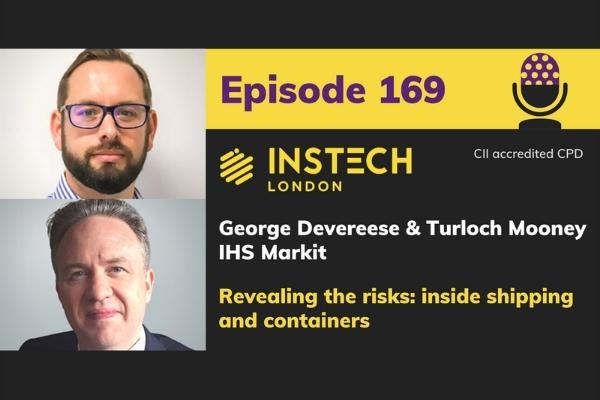The global pandemic and the shutdown of the Suez Canal in March highlighted the importance of the global supply chain and the risks involved in shipping goods around the world.
Tracking what happens at sea is a major challenge, however, innovations in data and technology are now allowing insurers and businesses to track ship and cargo movements from start to finish.
Matthew is joined on Podcast 169 by George Devereese and Turloch Mooney from IHS Markit, a global data provider and the primary source of information on vessels being used for international trade.
The conversation covers how technology is being used in the real-time monitoring of vessels and the data and analytics IHS Markit provides to marine insurers to assist with underwriting, risk allocation, and claims investigation/mitigation.
Talking points include:
- The main risks involved in container ship journeys
- How sensors are being used to track individual cargo containers
- Using data to forecast global supply chain delays
- Partnering with insurers and accessing IHS Markit data
- The next steps in supply chain and marine insurance innovation
If you like what you’re hearing, please leave us a review on whichever platform you use, or contact Matthew Grant on LinkedIn.
Sign up to our newsletter for a fresh view on the world every Wednesday morning.
Continuing Professional Development – Learning Objectives
InsTech London is accredited by The Chartered Insurance Institute (CII). By listening to an InsTech London podcast, or reading the accompanying transcript, you can claim up to 0.5 CPD hours towards the CII member CPD scheme.
The Learning Objectives for this podcast are:
- Describe how maritime shipping data can be used in insurance
- Compare some of the possible ways to track containers
- Identify some of the additional uses of maritime shipping data
Let us know you have listened to this podcast by emailing [email protected] and if your organisation is a member of InsTech London you will receive a quarterly summary of the CPD hours you have earned.
To help us measure the impact of the learning, we would be grateful if you would take a minute to complete a quick feedback survey.
Revealing the risks: inside shipping and containers – Episode 169 highlights
Matthew: IHS Markit provides 50,000 customers in 140 countries with information and insights into critical business areas such as shipping. What does IHS Markit provide to insurers specifically?
George: IHS Markit is a global information provider. We operate across many business sectors including maritime, trade, war, and terrorism. IHS Markit also operates across the energy and financial sectors. If something is insured, we may have some relevant data to offer.
Matthew: Can you describe what happens on the journey of a shipping container?
George: A container is loaded (or “stuffed” as they say in the industry) at a factory. Containers then go by road or rail to the port and can spend a couple of weeks there. They are then loaded onto the container ship with a very rigorous process that takes account of their weight and where they are being unloaded.
Matthew: What can go wrong with containers that would be of interest to insurers?
George: A container is a metal box, so you cannot see inside it. A lot of trust is placed on the people who stuff the containers being honest about what is inside. A container where the true weight is significantly higher than what is recorded may be placed too high and crush the containers below. Another issue is where chemicals are not properly declared and a spillage occurs, which can be very dangerous. In rough weather, if containers are not secured correctly, they can roll into the sea. For example, the Maersk Essen lost 750 containers in January 2021 in the Pacific.
Matthew: How are individual containers tracked independently?
George: All containers have an individual number on them. The containers can be tracked via their bill of lading (a legal document issued by a carrier to a shipper that details the type, quantity, and destination of the goods being carried). Every move of a container is referenced and tracked by entering the bill of lading into a computer.
Matthew: Is it possible to track containers remotely through sensors?
George: The question with individual container tracking is where to put the sensor. If it’s on the outside it’s likely to get knocked off. It’s difficult to put the sensor inside as a lot of the time the container has to be retrofitted. There’s also the problem with stacked containers: how does the bottom one in the hold below deck send a signal out to the satellite? It tends to be done by what is known as a hive system, where the containers can communicate to one that has line of sight to satellites. They then broadcast out as a collective. There are companies looking into improving this process.
Matthew: Turloch, can you talk about IHS Markit’s new data set for global shipping lines?
Turloch: I look after IHS Markit’s port performance data. This data allows container port and terminal performance to be measured and compared at a granular level. For example, our clients can see how ports and terminals compare with regards to how long vessels are waiting before they can berth and how long it takes to unload the containers. IHS Markit has standardised the definitions across the global industry for metrics like vessel waiting times, anchorage times, time required to prepare the vessel for work, unloading times, and so on.
Matthew: How is the port performance data being used by your clients?
Turloch: We have clients that are terminal and port owners that can use it to benchmark their terminal or port with competitors. The data can also be used to investigate specific operational issues or longer-term causes of delay and congestion. For organisations that want to understand supply chains, our data can be used to track congestion levels or to identify trends that might indicate worsening delays. The data is used by maritime and logistics professionals for supply chain planning.
Matthew: Are underwriters using any of this data?
George: Underwriters need to assess potential damage to cargo. An example is with refrigerated containers. If there’s a delay, containers can be unplugged which can lead to temperature variance and damaged cargo. IHS Markit sees this issue with soybeans. Temperature variance means that caking can occur on the top of the cargo load. The receivers will reject the cargo because the first small layer has caked, even though the rest is fine. In terms of insurance, this can become expensive.
Matthew: What is causing the shipping delays we’ve been seeing in the past year?
Turloch: The direct operational cause of the congestion occurring at the moment is excessive growth in average call sizes. Call size is the average number of containers that are loaded, restowed or unloaded per vessel call. Our data tracks call size growth. Since the end of 2020, it’s been growing at an incredibly high rate. There is a lot more cargo coming off vessels at one time but infrastructure, labour and processes may not be sufficient to accommodate it without delays.
Matthew: Is IHS Markit able to forecast what supply chains may look like next year?
Turloch: We use data to underpin our forecasts for port congestion and the wider supply chains. IHS Markit predicts that it will take a while for the congestion to ease due to the existing cargo backlogs and the fact that supply chain inventory levels are very low at the moment. This is also a busy time of year for shipping, and congestion will not reduce until demand drops. Even when demand falls back it will still take many months to clear the backlogs.
Matthew: What data sources would be helpful to complement what IHS Markit is already doing?
Turloch: Our data currently focuses on ocean metrics, so a next logical step could be exploring the land side. This would include cargo dwell time, which is the average amount of time cargo has to spend from when it is offloaded to when it exits the port gate. We could also explore the intermodal side, which includes trucking and rail data.
George: On the maritime side, we’re very reliant on AIS (automatic identification system) data. Although it’s only been in existence for 30 years, the technology that underpins it is VHF radio, which is 95 years old. We’re currently looking at better ways to track vessels. One example involves looking at cargo movement data. IHS Markit is also looking into satellite imagery to fill the AIS gaps, but there are challenges as container ships all look very similar from above.
Matthew: What other areas of information do you provide relative to shipping and cargo?
George: On behalf of the IMO (International Maritime Organisation), IHS Markit issues number plates for ships. If a vessel is over 300 gross tonnes and engaged in international trade, it requires a number plate. IHS Markit is the only company that issues those number plates. When we issue it, IHS Markit acquires vast quantities of data on each of the vessels.
Matthew: How can those interested get access to your data?
George: Our data can be accessed via free websites such as MarineTraffic. IHS Markit also has its own in-house systems that can be used. Insurance-specific companies have also partnered with us, such as Concirrus for its Quest Marine product. Please contact me directly if interested.
Matthew: Why did IHS Markit join InsTech London as a corporate member?
George: Being able to reach out to companies that use data for insurance is really helpful. I’m mainly focused in the maritime world. Speaking to the broader insurance network is really important in sparking conversations which often lead to new pathways we never knew existed.
Matthew: To finish off – what is the largest number of containers that can fit on a ship these days?
George: There are 12 ships sailing around the world today that have capacity for 24,000 containers.






